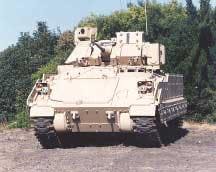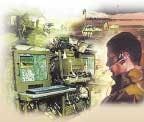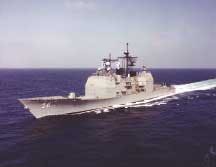Army picks Vista board for Bradley Fighting Vehicle
Engineers at the U.S. Army Tank, Automotive, and Armaments Command (TACOM) in Rock Island, Ill., needed a universal electronic-circuit-card assembly for the Bradley Fighting Vehicle (BFV). The Wildcard — from Vista Controls in Littleton, Mass., a division of Curtiss-Wright Controls Inc. — met their needs.
The Wildcard is a common module that can go into any of seven slots on the turret distribution box (TBD) found on the Bradley A2/A2ODS.
It will replace any/all of the originally designed unique analog boards, which distribute power and logic for the vehicle's turret, controlling the TOW System Select, Weapon Select, Weapon Control, Ammo Feed Select, Status Light Control, Deck Clearance, and TOW System Arming operations, according to Vista Controls officials. Having one board that can replace any of seven unique boards greatly reduces the logistics effort required to support the Bradley A2s and A3s.
For more information, see www.vistacontrols.com.
F-35 Joint Strike Fighter uses Actel FPGA for engine electronics
Engineers at Hamilton Sundstrand in Windsor Locks, Conn., needed a processor aboard the F-35 Joint Strike Fighter (JSF) to manage the communication protocol in the engine-control system and to serve as the interface to the engine's central processing unit. They found a solution with Actel Corp. in Mountain View, Calif., in the ProASIC Plus, a flash-based, field-programmable gate array (FPGA).
The chip's reprogrammability enabled rapid prototyping of the new high-speed communication protocol, while its nonvolatility and single-chip form factor enabled engineers to meet the system's tight board-space constraints, Actel officials claim. Hamilton Sundstrand designers also used Magma Design Automation's PALACE physical-synthesis tool for programmable logic devices, available as part of Actel's Libero Integrated Design Environment (IDE), for more efficient high performance.
"The combination of reprogrammability and nonvolatility provided by Actel's ProASIC Plus FPGAs was critical in our selection process as we looked for a solution that allowed us to prototype quickly and would also take us through production. Design security and firm-error immunity were also strong considerations in the selection of an FPGA for this design," says Patrick J. Sears, senior FPGA design engineer, ASIC group at Hamilton Sundstrand. "Additionally, we were impressed by PALACE and its ability to improve our overall design performance by as much as 50 percent."
For imore nformation see www.actel.com.
Lockheed Martin engineers streamline design cycle with Agile PLM
Military and aerospace designers at Lockheed Martin needed a way to reduce product development time for their advanced-combat systems and missile, rocket, and space systems. They found a method in the product-lifecycle-management (PLM) suite from Agile Software Corp. in San Jose, Calif.
Lockheed leaders rolled the software out to 3,000 users, and consolidated more than 28 million pieces of product data and information from 15 databases into a single enterprise PLM system with a common set of business processes and tools.
They integrated it with Pro/ENGINEER computer-aided-design (CAD) software and i2 Component Supplier Management systems. Lockheed Martin's engineering departments also implemented configuration-management capabilities, including the ability to trace serial numbers, and to compare "as designed" and "as planned" bills of material (BOM), Agile officials say.
"Aerospace and defense manufacturers are under tremendous pressure to improve margins and cost efficiencies," explains Ed Miller, president of CIMdata, an independent PLM consulting and research firm. "PLM solutions like Agile's can help these companies transform the way they develop products. It is critical that these solutions provide the ability to integrate with existing systems and to maintain a single consistent product-structure definition throughout the design and manufacturing process. This can reduce the time to market and operating costs, and contribute to improved quality, ultimately improving product margins."
For more information, see www.agile.com.
General Dynamics picks General Micro Systems for amphibious-vehicle computer
Engineers at General Dynamics Land Systems, Sterling Heights, Mich., recently selected the P60x single-board computer from General Micro Systems in Rancho Cucamonga, Calif., to perform command-and-control functions for the U.S. Marine Corps' Expeditionary Fighting Vehicle (EFV).
The SBC module will perform all the client functions, including mapping, situational awareness, and vehicle control.
The EFV, formerly known as the Advanced Amphibious Assault Vehicle, will let a driver maneuver, while the vehicle is loaded with a Marine rifle squad, at 20 to 25 knots in the water, and at 45 mph on land, about equal speed to the M1 Tank. The EFV will replace the Marine Corps' aging current AAV7A1.
The P60x is the first single-board computer based on Intel's new Embedded Roadmap Pentium M Processor 745 (formerly known as Dothan), General Micro Systems officials say. The new busless SBC measures just 4 inches by 4 inches, and consumes only 12 watts of power, company officials claim. It is designed for applications in embedded industrial-PC control-and-defense platforms that require high-speed numeric, data and video/graphics processing, ultra-low power consumption, and scalability.
"Intel has done a phenomenal job with the Pentium M class, and we are excited to offer the first SBC to leverage its high-speed processing and power-savings capabilities," says Ben Sharfi, president of General Micro Systems. "Not only is the Pentium M Processor 745 faster than a comparable PowerPC 7447, it consumes less power."
For information, see www.gms-.4sbc.com.
VMETRO and Marine Corps use BitMicro disks to test helicopters
Engineers at VMETRO in Houston are using solid-state disks (SSD) from BitMicro of Fremont, Calif., for their digital data recorder (DDR), used to test weapons systems on AH-1Z Cobra Helicopters.
The DDR is the basis of a new system developed to debug and qualify the Hawkeye Target Sight System (TSS) currently being tested by Lockheed Martin Missiles for the AH-1Z Cobra Helicopter of the U.S. Marine Corps.
The TSS is a multisensor EO/IR fire-control system (AN/AAQ-30) designed to provide target detection, recognition, and identification at extremely long ranges during day or night operations and in challenging environments. With E-Disk Fibre Channel flash-based SSD as its mass-storage device, DDR has the capability to sustain high-bandwidth data recording in hostile environments, enabling test personnel to correlate what the sensors are seeing with the indicators coming from the weapons system of the AH-1Z, BbitMicro officials say.
"The Fibre Channel interface enables direct integration of the E-Disk with VMETRO's Data Recording Storage Area Network (DR-SAN). With a total of 48 gigabytes of storage, the E-Disk flash drive provides adequate storage for entire test flights with no need for aircraft landing," says Ronnie Sanford, VMETRO's manager of marketing.
For more information, go online at www.bitmicro.com.
Aurora patrol plane uses multicomputer from Mercury
Engineers at Telephonics Corp. of Farmingdale, N.Y., needed a muticomputer for the radar in the Canadian air force's CP-140 Aurora Incremental Modernization Program.
The COTS RACE++ system from Mercury Computer Systems in Chelmsford, Mass., met their needs.
Aurora is a long-range patrol aircraft able to fly more than 5,000 miles without refueling, and is Canada's strategic airborne, land, and sea surveillance aircraft. Mercury's systems will provide the processing power needed to increase the range and performance of the inverse synthetic-aperture radar (SAR), called the advanced APS-143B(V)3-MPA OceanEye Surveillance Radar, Mercury officials say. The upgraded imaging radar will enable the air force to detect, classify, and track targets or objects at sea and on land, for applications including search and rescue, sovereignty, and counter-drug patrols.
"Mercury's RACE++ computers are at the heart of the radar, providing the high-end computing and bandwidth necessary for this new system," says Richard Frazita, vice president, program management at Telephonics Corporation. "We look forward to working with Mercury to deliver and support a radar system that will meet the needs of our prime contractor, MacDonald, Dettwiler and Associates LTD, and the Canadian air force."
For information, see www.mc.com.
Northrop Grumman uses Mercury computer for MP-RTIP radar
Planners at Northrop Grumman Corp. in Baltimore needed a powerful computer for their next-generation military radar. They found a solution at Mercury Computer Systems, of Chelmsford, Mass.
Northrop will use Mercury's RapidIO-based PowerStream 7000 system, which delivers 1 trillion floating-point operations per second of processing power in a small volume. That computer will power Phase II of the U.S. Air Force's Multi-Platform Radar Technology Insertion Program (MP-RTIP).
MP-RTIP is a next-generation, modular, scalable radar system that builds on the capabilities of its predecessor, the Joint Surveillance Target Attack Radar System (Joint STARS). Northrop Grumman is prime contractor for the $888 million Phase II stage, which the Air Force plans to use on the RQ-4B Global Hawk unmanned aerial-reconnaissance system and the E-10A/Multi-Sensor Command and Control Aircraft (MC2A).
Northrop Grumman designers also used a Mercury computer in the Phase I MP-RTIP, which runs on the PowerStream MP-510. Northrop recently made the $8.3 million order for development of long-lead items for Phase II, and Mercury expects a larger follow-on Phase II contract later this year. For more information, see www.mc.com.
Navy ship designers choose SGI for visualization
Ship designers at the Naval Surface Warfare Center's Carderock Division in Bethesda, Md., were building a Center for Concept Visualization (CCV) to speed their designs and needed a visualization technology. They found a solution in the Onyx Advanced Visualization System from SGI in Mountain View, Calif.
The CCV is a ship-system analysis and design facility, used by teams of Navy scientists, engineers, and designers to view and test immersive visualizations of new ship designs, reducing the time and cost of building ships while stress-testing designs for particular sea and battle conditions.
The system performs tasks such as hydrodynamic and hydroacoustic volumetric visualization, examining water flow and noise transmission in and around ships and submarines, and predicting ships' maneuvering characteristics, top speed, and counter detection ranges.
The CCV's core visualization technology uses an SGI Onyx 3800 visualization system with InfinitePerformance graphics. Running on seven gigabytes of shared main memory and 28 processors, it creates an immersive real-time environment, using three Christie Mirage 2000 projectors to compile a 21-foot-wide active stereo VR image with a resolution of 3,328 by 1,024.
"With the SGI Onyx 3800 and InfinitePerformance graphics technology, the CCV represents an important advance in Navy ship-design technology," says Doug Dahmer, operations manager with Naval Sea Systems Command (NAVSEA) Hydrodynamic/Hydroacoustic Technology Center (H/HTC). "We are producing more detailed, more realistic, and more illuminating views of ships earlier in the design process than ever before."
For more information, see www.sgi.com.
Navy weapons designers use Primagraphics subsystem for Mk34 gun system
Engineers at the U.S. Navy's Naval Surface Warfare Center (NSWC) in Dahlgren, Va., needed a new display subsystem to meet the requirements of the MK34 Gun Weapon System in the Aegis CG-47 Class Cruiser Conversion program. They chose a solution from Primagraphics in Charlottesville, Va.
The Primagraphics subsystem uses a variety of commercial off-the-shelf (COTS) cards, including a Hawkeye single-board radar-scan converter, a Cobra quad video windows card, a Panther display card, and a Sentinel record-and-replay system.
Together, they accept specialized radar video-input formats, multiple camera video inputs, support for maps, and numerous X-window graphics overlays to provide real-time digital-display recording, Primagraphics officials say.
The end result is a radar- and video-display subsystem for the Gun Weapon System Consoles. The Mk34 Mod 1 Gun Weapon System is a subsystem of the Aegis Combat System and interfaces with the Naval Fires Control System. It includes the Mk45 Mod 4 gun, Mk160 Gun Computer System, and the Mk46 Optical Sight.
The Mk45 Mod 4 gun is a 5-inch/62-caliber weapon that replaces the older Mk45 Mod 2 version — which has a range of only 13 nautical miles. The Mod 4 gun fires either a conventional 5-inch round or the ERGM (Extended-Range Guided Munition), a 110-pound, global positioning system (GPS)-guided, rocket-assisted trajectory projectile with a range of more than 50 nautical miles.
For more information, see www.primagraphics.com.
Racal picks Crystal Group computers for test & measurement
Designers at Racal Instruments Group were designing an Automatic Test-Equipment (ATE) system for their customer, the United Kingdom Ministry of Defence. They needed a custom-made rugged computer and found a solution with Crystal Group Inc. of Hiawatha, Iowa.
Racal has tasked Crystal and their British partner, Acal Electronics, with delivering 90 production units by this month.
U.K. forces will use the units in Racal's TILS (Technology Insertion into Legacy Systems) solution, a way to counter obsolete test instruments by translating outdated commands into language that new parts can understand.
"Crystal understands the issues that governments face with using commercial off-the-shelf (COTS) systems. This opportunity aligned with Crystal's goal of bridging the gap between COTS and custom by easing the pain of obsolescence," says Scott Kongable, president of Crystal Group.
"We chose the Acal Electronic/Crystal Group team because of their quick-turn ability," says David Arbuckle, project manager of Racal Instruments Group. "We needed the system developed within a very short time frame, and Acal and Crystal Group really came through for us."
For more information, see www.crystalpc.com.
British air force picks Rockwell Collins for software-defined radio
Engineers in the United Kingdom Ministry of Defense (MOD) needed software-defined, V/UHF radios for the Harrier ground-attack aircraft. They found a solution in the Talon, from Rockwell Collins (UK) Ltd., Reading, England.
The Rockwell Collins Talon radio uses advanced anti-jamming and security features that use flexibility through software control, Rockwell officials say.
The device provides normal and secure two-way voice and data communications over the 30- to 400-MHz frequency range. The system's advanced digital signal processing and software-centric architecture provides an integrated system that is flexible, compact in size, and enables growth within the radio through software modifications in the field. Functions traditionally accommodated in individual or federated pieces of hardware have been embedded in software, providing the user the benefits of an integrated communications system with adaptability to future requirements, Rockwell officials say.
The system can be configured with multiple electronic counter-countermeasure options, including the Second-generation Anti-jam Tactical UHF Radio for NATO (SATURN) waveform. The Talon is also capable of implementing the Single Channel Ground Air Radio System (SINCGARS) waveform in the low VHF-frequency range and the HAVE QUICK waveform in the UHF frequency range.
The radio is fitted to a range of British aircraft in addition to the Harrier, including the E3D AWACS, Nimrod Maritime Patrol aircraft, and the Chinook Helicopter. The latest order brings the total value of Talon radios supplied to the MOD to $24 million.
For more information, see www.rockwellcollins.com.
Army uses DRS diagnostic system in Abrams Tanks
Engineers at the U.S. Army's Tank-Automotive and Armaments Command (TACOM) in Warren, Mich., needed an embedded diagnostic system to keep their M1A1 Abrams main battle tanks running.
They found a solution with DRS Technologies Test & Energy Management unit in Huntsville, Ala.
DRS will produce Sidecar Embedded Diagnostic Kits — rapidly deployable, commercial off-the-shelf (COTS)–based systems that will improve sustainability, increase readiness and mobility, and reduce maintenance costs for the Abrams tank fleet, making it easier for Army National Guard troops to rotate onto active duty.
The kits identify electronic system faults, reducing maintenance time and logistics. They monitor analog and discrete signals, then use a high-speed databus for real-time data collection and analysis.
Each system receives power via the combined data/power Sidecar Cable, relying solely on battery power. Used in conjunction with a host controller, Sidecar Data Acquisition Units provide a complete embedded diagnostic solution for the Abrams tanks. For more information, see www.drs.com.







